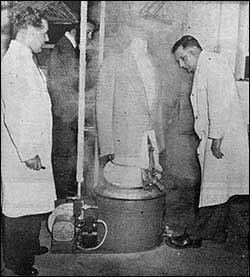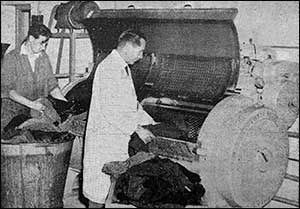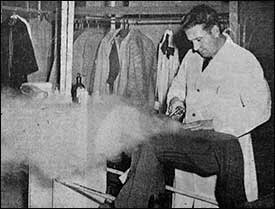 |
|
This is latest thing in wrinkle removers. Just button the jacket on the hollow dummy, press the operating pedal, and presto... you get 15-second rations of steam, not air, and cold air to give that smooth, well-pressed look. In this wholly automatic works even the £2,000 furnace stokes itself.
|
County's most modern dry clean plant
Dark and dapper Arthur Mills, head of the county's most modern dry cleaning plant, is his firm's best advertisement. He illustrates his faith in up-to-date methods by pointing to his own immaculately pressed suit and saying: "This one has been cleaned thirty times."
The newly-built Express Dry Cleaning Works, Wellingborough Road, Rushden, is a showplace to which trade representatives from all parts of the country have been flocking. Three months ago the equipment was on view at Olympia in the Dry Cleaning Exhibition. Now it is cleaning 300 Northamptonshire garments every hour the modern way.
This is the latest thing in wrinkle removers. Just button the jacket on the hollow dummy, press the operating pedal and presto you get 15-seconds rations of steam, hot air, and cold air to give that smooth, well-pressed look. In this wholly automatic works even the £2,000 furnace stokes itself.
15,000 Gallons
Secret of this modern process lies in the spirit - 15,000 gallons of it - which is always circulating and always pure.
Previous methods involved a revolving bin into which the clothes were placed for cleaning - first the light colours, then the wool, then the silk, and finally the navy blues and dark colours.
And for the whole batch the same spirit was used. Hence the "muddy coloured" linings that was a feature of so many dry-cleaned garments.
Four Ounces
Says Mr. Mills: "In the trade it is assumed that each garment contains four ounces of dust and dirt. You can guess what the spirit looks like after a day's work if it is not changed."
 |
|
Into the cleaning drum goes 100 pounds of soiled clothing. For twenty minutes the garments will roll backwards and forwards as the cleaning spirit is pumped through. This expensive piece of machinery is just one link in a chain of
modern dry cleaning processes.
White smocked operator is Mr Neville Amos.
|
At the Express Works clean spirit is pumped into the cleaning drum, through the clothes, and out. It goes to a 20ft high filtration plant, where it passes through three chemical layers - the first to extract grease, the second to take away colours, and the third to remove odours.
To make completely sure the spirit is clean it is mixed with water and aerated in a special machine, which swirls it at something like 1,800 revolutions a minute. Only then is it ready for cleaning clothes once again.
This spirit is a by-product of petrol. It is quite possible to run a car on it. "Do I?" asked Mr. Mills. "No fear! It costs 4s 7d a gallon, and I can buy petrol at 4s 6½d."
But the spirit treatment is only part of the dry-cleaning process. Each garment is handled ten times in all.
Before leaving the cleaning department clothes have to go through a hydro, into a tumbler, and finally on to a spotter.
£500 "Colander"
While being cleaned a suit soaks up four gallons of spirit which has to be removed, that's where the hydro comes in. This £500 "revolving colander" spins the clothes so fast that all liquid is removed in a matter of minutes.
From there the articles go into an £850 tumbler for another spin in hot air. The clothes are dry by this time, and all set for the spotter.
"Leave It Alone"
 |
|
Steam hisses from a high pressure gun as spotter Walter Downes removes yet another stain. Every garment is individually checked for spots before it leaves the cleaning department. This is the halfway stage in dry cleaning. Each article goes through ten different processes.
|
The spotter is Walter Downs. He works with a high pressure steam gun, soap solution, and a bewildering array of chemicals. His is the task of removing all stains which the spirit left. Walter had some very good advice to those who spill anything on their clothes: "Leave it alone."
Almost anything can be removed without a trace if the dry-cleaner's attention is drawn to it. They like to know just what the stain is, and can act accordingly. But often a stain has been "mucked about" before reaching the works. On some occasions that proves disastrous.
The degree of difficulty in removing spots depends a good deal on the type of material. Said Mr. Mills: A gallon of oil or a pot of paint down your best suit is easy. Our worst jobs are fruit juices, coffee and tea stains. But leave it to us, please.
Finishing comes next. First moulding on tailor's dummies, through which steam, hot and cold air are passed; then pressing, individual inspection, finally packing.
Mr. Mills can point to a pair of trousers that have been cleaned 57 times. He has cleaned one American suit three times in one week. He says Americans are much more "dry-clean conscious" than the British.
And one last thing before sending clothes to the dry-cleaners make one final search through the pockets. If you don't you may add to the collection of watches, wedding rings, pens and paper money that are everyday finds at the works.
Biggest recent find at Mr. Mills' works was a wallet containing twenty pound notes. False teeth are almost an everyday occurrence.